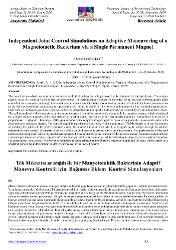| dc.contributor.author | Tabak, Ahmet Fatih | |
| dc.date.accessioned | 2023-10-19T14:55:53Z | |
| dc.date.available | 2023-10-19T14:55:53Z | |
| dc.date.issued | 2020 | |
| dc.identifier.issn | 2148-2683 | |
| dc.identifier.uri | https://doi.org/10.31590/ejosat.818986 | |
| dc.identifier.uri | https://search.trdizin.gov.tr/yayin/detay/484679 | |
| dc.identifier.uri | https://hdl.handle.net/20.500.12469/4609 | |
| dc.description.abstract | The use of micro-robotic systems in non-invasive medicine has been heavily promoted in the literature for the last decade. The studies usually focus on artificial or biohybrid microswimmers of various origins subject to the effect of an external electromagnetic field controlled by a computer. Although there exist several motion control studies shared to date, control of a bio-hybrid microswimmer has rarely been demonstrated employing an open kinematic chain, in detail. In this work, motion control of an isolated magnetotactic bacterium cell (Magnetospirillum Gryphiswaldens) is presented via a magnetic field actively positioned by an open kinematic chain. The cell is modeled with its complete environment to make it as realistic as possible along with the magnetic torque, which is induced by a single magnet attached at the end effector of a robotic arm, exerted on it for maneuvering control. The control is based on a proportional – integral – derivative (PID) gain scheme with adaptive integral gain to focus on a particular steady-state error with discontinuous reference signals. The control signal is transformed into pulse width modulation (PWM) signals to drive the motors articulating the joints of the open kinematic chain, the inverse kinematics of which is designed to be simple enough to achieve independent joint control. A numerical analysis of the coupled system is carried out in the time domain. The performance of the said motion control approach is investigated for each degree of freedom for the planar motion of the microswimmer. Simulations demonstrate a planar open kinematic chain is capable of control the gait of the microswimmer while following its trajectory near a planar boundary via independent joint control. Furthermore, simulations demonstrate that the effective magnetic inertia and the shear stress results in a small but certain lag in the motion control performance of the overall system. | en_US |
| dc.language.iso | eng | en_US |
| dc.relation.ispartof | Avrupa Bilim ve Teknoloji Dergisi | en_US |
| dc.rights | info:eu-repo/semantics/openAccess | en_US |
| dc.title | Independent Joint Control Simulations on Adaptive Maneuvering of a Magnetotactic Bacterium via a Single Permanent Magnet | en_US |
| dc.type | article | en_US |
| dc.identifier.startpage | 50 | en_US |
| dc.identifier.endpage | 59 | en_US |
| dc.identifier.issue | Ejosat Özel Sayı 2020 (ISMSIT) | en_US |
| dc.identifier.volume | 0 | en_US |
| dc.identifier.doi | 10.31590/ejosat.818986 | |
| dc.institutionauthor | Tabak, Ahmet Fatih | |
| dc.relation.publicationcategory | Makale - Ulusal Hakemli Dergi - Kurum Öğretim Elemanı | en_US |
| dc.identifier.trdizinid | 484679 | en_US] |
















